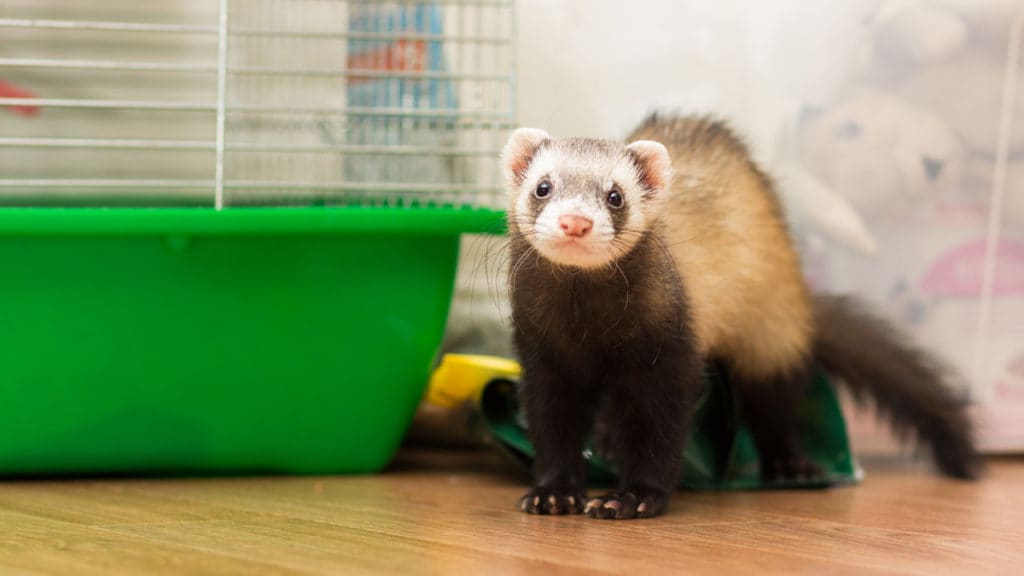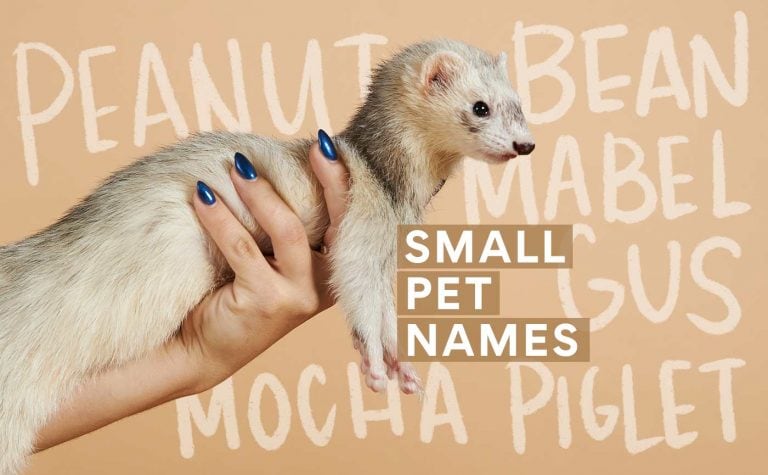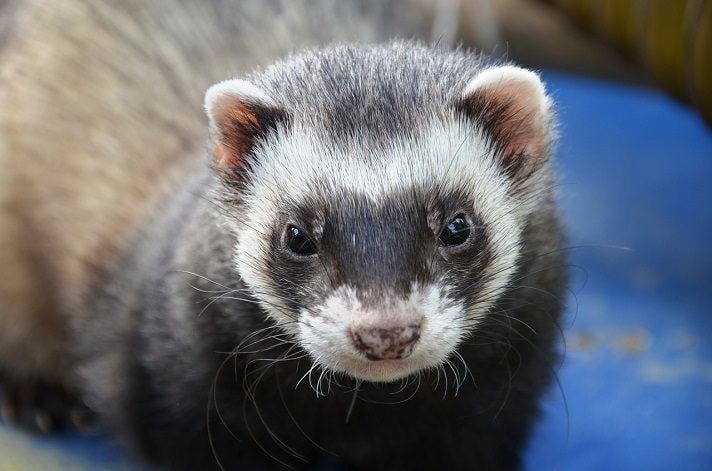As our ferret companions journey from birth to old age, they experience changes similar in some ways to the changes experienced by aging people. Those changes include hair loss, hair thinning, tooth decay, and changes to appetite, mobility, physical structure, personality and temperament. The changes discussed in this article apply to healthy ferrets, not ferrets affected by disease.
Physical Structure
Ferret babies (kits) are born weighing 10 to 12 grams with eyes and ears closed, and are normally pink in body color. They start showing “peach fuzz” fur on Day 1 or 2 and have their baby hair at about 4 or 5 weeks of age. They are totally dependent upon their mother for survival. By 4 weeks of age, their weight is around 200 grams, or 8 ounces, and they start to blindly investigate their surroundings. By week 5 or 6, they open their eyes and ears and start to explore everything they see. By 8 months of age, the ferret kit reaches its adult structure.
The average weight for a neutered, adult female ferret is around 1 pound 6 ounces; the average weight for a neutered, adult male ferret is 2 to 4 pounds. A hob (intact male) can mature to a weight of 5 or 6 pounds, and a jill (intact female) can reach about 2 pounds 6 ounces.
The first two years of a ferret’s life is his prime. The ferret’s physical structure should have strong bone density, good muscle tone and a thick full coat. This is similar to the strong bone density, strength and good muscular appearance of a 25-year-old person.
A ferret kit develops his adult teeth by 8 weeks of age. As they age, their teeth slowly become more and more opaque. The teeth also wear down. Plaque buildup and gum disease may occur, so brushing and cleaning of the teeth is important to help maintain a healthy ferret, whether young or old.
Nipping And Chewing
Expect ferret kits to be mouthy, just like a kitten or puppy. Proper socialization helps them learn that rough play is not acceptable for tender human skin.
By 6 months of age, ferret kits should be appropriately socialized, with the nipping decreasing as they learn. Proper socializing is imperative; it affects the rest of the ferret’s life. Many ferrets end up in shelters tagged as “a biter.” In many instances, “a biter” can be traced to nonsocialization and/or abuse.
Ferrets chew anything they can get their mouths on. Many kits carry their desire to chew on into their adult life. Because of this, ferret owners must frequently examine their pet’s bedding and play toys inside ferret cages.
Kits are notorious for chewing through towels, shirts, blankets, sleep sacks or any other item used for bedding. Missing pieces of bedding could have been ingested. Ferrets tend to love chewing on plastic, rubber bands, cloth and other items that can cause an intestinal blockage.
Physical Mobility
Kits are curious, and once their eyes open, everything is new to them. Each ferret demonstrates different levels of athletic ability. The mobility of a ferret kit is extremely high — enabled by high energy and high curiosity. Ferrets up to 1 year old are usually going flat out or sleeping like the dead.
Older ferrets lose a lot of mobility with age, usually due to lost muscle tone and bone density. Older ferrets slow down, losing the desire to climb and jump very much; they aren’t as “bouncy.”
Other aspects of mobility are the digging and escape attempts. Ferrets are well-known for their determination in their attempts to escape. They can slip out of an open door faster than you can blink an eye. These traits never seem to change, although younger ferrets tend to be more persistent.
Behavior
Most pet ferret companions are neutered at 5 or 6 weeks of age, so they usually don’t exhibit behavior associated with an intact ferret. Intact ferret kits develop behaviorally and physically differently.
Late-altered kits tend to be larger and robust. Intact males develop testes and demonstrate sexual behavior, which includes dragging around another ferret by the scruff or mounting behavior. As a kit, they are practicing. Intact females come into breeding season at approximately 7 months of age and develop a swollen vulva and show extreme interest in male ferrets. Intact ferrets normally come into breeding season twice a year, and these behaviors can become extreme.
After neutering, late-alter ferrets develop the same as a ferret that was an early-neuter, and the sexual behavior ceases. If an early-neuter kit demonstrates any or some of the sexual behavior of an intact ferret, a trip to the veterinarian is recommended.
A healthy ferret kit will grow into a healthy adult. As the ferret ages (4 years and up), expect the ferret to remain alert, interactive and playful. But his energy and playfulness decreases with age. As a kit, a ferret might play for hours, but do not be surprised if your 5- or 6-year-old ferret doesn’t have the energy to play for hours. An aging ferret may play for 30 minutes, take a nap and then wake to play again. This is normal as long as the ferret is alert, playful and interactive for the period of time when he is up and about.
Some ferrets at very advanced ages start to miss the litter box at times. Extra care such as feeding a daily “ferret soup mixture” (a high-calorie, easy-to-digest food) can help the oldster retain better health and consume beneficial extra fluids and nutrients. Care needs to taken to make sure that senior ferrets are able to eat their normal diet; if not, a modified diet is required.
Every ferret can and will age differently. With age, female ferrets tend to mellow out and the males become more laid-back. They become the cuddle bugs we love.
Coat Change
Ferret kits usually shed their baby coats and grow their adult coat by 1 year of age. Ferrets normally go through two coat changes each year. During summer, they sport a short, smooth, silky coat; in the fall, they develop a longer, fuller coat. In the spring, they shed the thick, longer, winter coat. Ferret owners must give a hairball remedy during these times, because ferrets ingest shedding hair as they groom themselves. A hairball can cause a gastrointestinal obstruction that might require emergency surgery to correct.
House temperature affects the development of a ferret’s winter coat. High house temperature might make it seem like summer to a ferret’s body, which stops the winter coat from growing.
A ferret’s coat coloring (lighter/darker) and face markings can change after a seasonal coat change. Coat change is sometimes dramatic. Although this is a normal progression, not all ferrets go through coat changes; it can vary with each ferret. Diet can play a major role in the condition of the coat and coat change. Supplements can help the conditioning of the coat.
Color pattern also plays a role. Albinos will always be albinos. The roan or silver will lighten up and become white as a ferret ages. The darker color patterns — sables, black sables — show graying most predominantly on their hind legs. Don’t get out your hair dye; ferrets don’t mind going gray. These changes are normal and should be expected.
Nose Coloration
Nose color can remain basically the same throughout a ferret’s life, which makes it a good identifying marker for similarly colored ferrets. Solid black noses normally remain the same throughout life, usually only becoming paler if a medical issue arises.
Nose color can vary some — getting darker and/or lighter, or developing or losing spots — but this should not affect your ability to use the nose as an identifying marker between similar ferrets. Although a ferret’s nose can lighten up with a coat change and aging, it can also alert you to medical issues.
Appetite/Weight
Normally ferrets bulk up (gain weight) for the winter season and lose weight for the summer. Most ferret owners note that older ferrets usually have a decrease in appetite. In our experience, we’ve noted that up to 3 years of age a ferret maintains its summer and winter weight, but as he ages his weight may not vary much between winter and summer.
Personalities
Ferret personalities can change. Often, older ferrets can be less interactive with their cage/playmates and become grumpy. Or the opposite, they become inseparable and crave and cling to their playmates. An aging ferret might also develop an intolerance of other animals (dogs, cats, etc.), their cagemates or you.
This becomes most evident if you attempt to add a new ferret kit to the group. Older ferrets tend to have less tolerance of the antics of a young, robust kit. Even the introduction of a new older ferret might be a problem. Older ferrets tend to be set in their ways and do not want change.
Veterinary Care
Younger ferrets as well as older ferrets need and must have regular veterinary care. Older ferrets can and will experience age-related problems.
Like this article? Check out another by Mike and Arita Morrett, click here.
For ferret behavior Q&As, click here.
For ferret health Q&As, click here.
By: Mike & Arita Morrett
Featured Image: Via iStock.com/FaST_9
Share:










